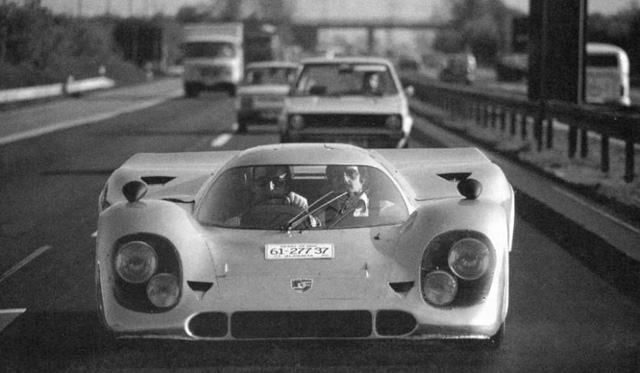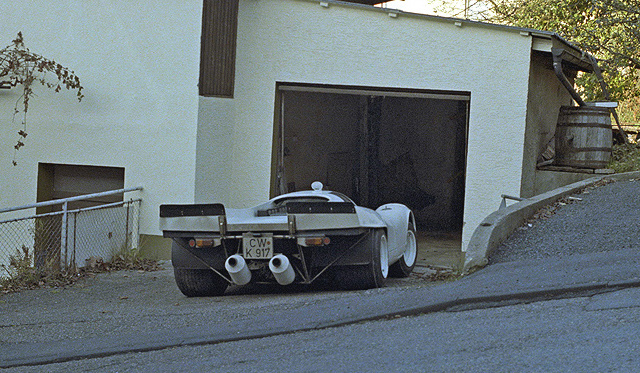
The Porsche 917 is without a doubt one of the most iconic racing cars ever made. The car dominated sports car racing in the early 1970s and gave Porsche its first overall win in the most prestigious endurance race in the world, the 24 Hours of Le Mans. The 917 shattered the competition on European circuits during it short career. In fact, the German racing car was so successful it was simply said being outlawed within a few years.
The Porsche crossed the Atlantic where it became the most powerful racing car ever made, and allegedly killed Can-Am racing. The Turbopanzer had an impressive racing career, but little known is the fact that two street-legal models were made – arguably the first hypercars.
One of the major sponsors for Porsche’s racing activities is Martini & Rossi. The first racing car with the distinctive blue and red stripes of the Italian distillery was the Porsche 917 which won the 1971 edition of the 24 Hours of Le Mans. Another Porsche 917, with chassis number 030, was also used by Martini Racing. But this car participated in one race only in which it failed to finish. Following this race Porsche 917-030 was used for testing of anti-lock braking systems before it was converted into a road car for Count Rossi.
The racing colors were removed and the car was painted silver, mufflers were added, and the interior was overhauled. These changes weren’t enough to deem to car roadworthy in Europe, but Count Rossi avoided this by registering his car in Alabama. Story goes the authorities in the American state provided Count Rossi a license plate for his Porsche, as long if he didn’t bring the car to Alabama!

And then there is the 21th built Porsche 917, which was delivered to AAW Racing in April 1970 for the Interserie championship. The Finish racing team initially painted the car red and yellow, but eventually opted for the famous mauve and green psychedelic livery, hence its nickname “Hippie Porsche”. Porsche 917-021 raced on circuits like the Nürburgring, Spa-Francorchamps and Monza. The car was also entered in the 24 Hours of Le Mans, where it crashed. A new chassis was installed and the season continued, which resulted in two victories: the Grand Prix at the Keimola Motor Stadium (which was owned by AAW Racing) in Finland and the Trophy of the Dunes at Zandvoort in the Netherlands.
After the 1970 season Porsche 917-021 was dismantled, the engine and suspension were installed in a Porsche 917 Spyder which would be used in racing the following year. The bodywork and chassis were sold to a Porsche specialist in Karlsruhe, southern Germany. These parts were collecting dust for three years until they were bought by Joachim Grossman, a carpenter and restaurant owner, who wanted to build a road-going Porsche 917. The incomplete Porsche was taken to his home in the small town of Bad-Wildbad in the Black Forest, where Grossman started restoring and modifying the car, a task which took over two years to complete.

The body was stripped from its racing colors and repainted white, turn lights were installed, and the original lightweight plexiglass windows were replaced by more solid glass. The interior received an overhaul as well to make it slightly more comfortable, it now featured white seats from made leather and blue floor mats bearing the car’s designation “917”. Remarkably there was also a hair dryer under the dashboard which served as a defroster.
An engine was bought from Willi Kauhsen, who had driven the famous Porsche 917/20 “Pink Pig” at Le Mans. Furthermore a gearbox and suspension was installed, and a more silent exhaust was fitted. Dunlop provided new tires suitable for road use, those at the rear measured almost an impressive 50 cm in width.
Joachim Grossman’s received an official manufacturers plate from Porsche, which meant the Stuttgart-based company acknowledged his modified 917 as a real Porsche. Eventually last hurdle was taken in June 1977 when the car passed the mandatory roadworthiness test in Germany and received a license plate bearing “CW-K 917”. The Porsche 917 was now ready to hit the Autobahn!

The street-legal 917 had a dry weight of 970 kg and according to official documents the detuned flat-twelve engine provided 550 horsepower at 7,500 rpm. The top speed of the car was 320 km/h. By comparison, the fastest road-going car in those day was the Ferrari 365 GTB/4 Daytona with a top of 280 km/h. With the possible exception of other modified racing cars it could be argued that the two street-legal 917s were the fastest road-going cars in the world until the arrival of the Ferrari F40 in 1987.
By that time Grossman had already sold his Porsche to a collector in Florida, who brought the car back to racing specs and used it in historical races. Nowadays Porsche 917-021 resides in Belgium and has been restored from the ground up, including the “hippie” livery. So the Count Rossi 917 remains the only street-legal 917 in the world, but chances are slim to none that this car will be spotted on the streets.
References:
Porsche 917-021 – The Fabulous Story by Jacques Breuer & Raymond Collignon
QV500.com – Porsche 917 Part 1: 917K ‘Straße’

















one of the coolest cars EVER the 917, the street legal version is WOW! 917 is one of the main reasons that made me love race cars as a kid.